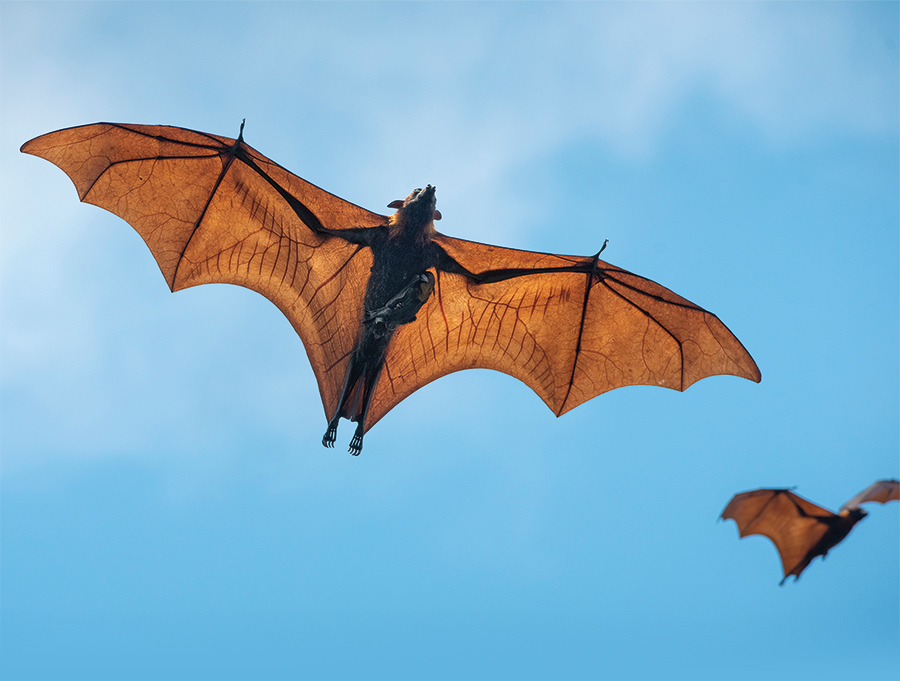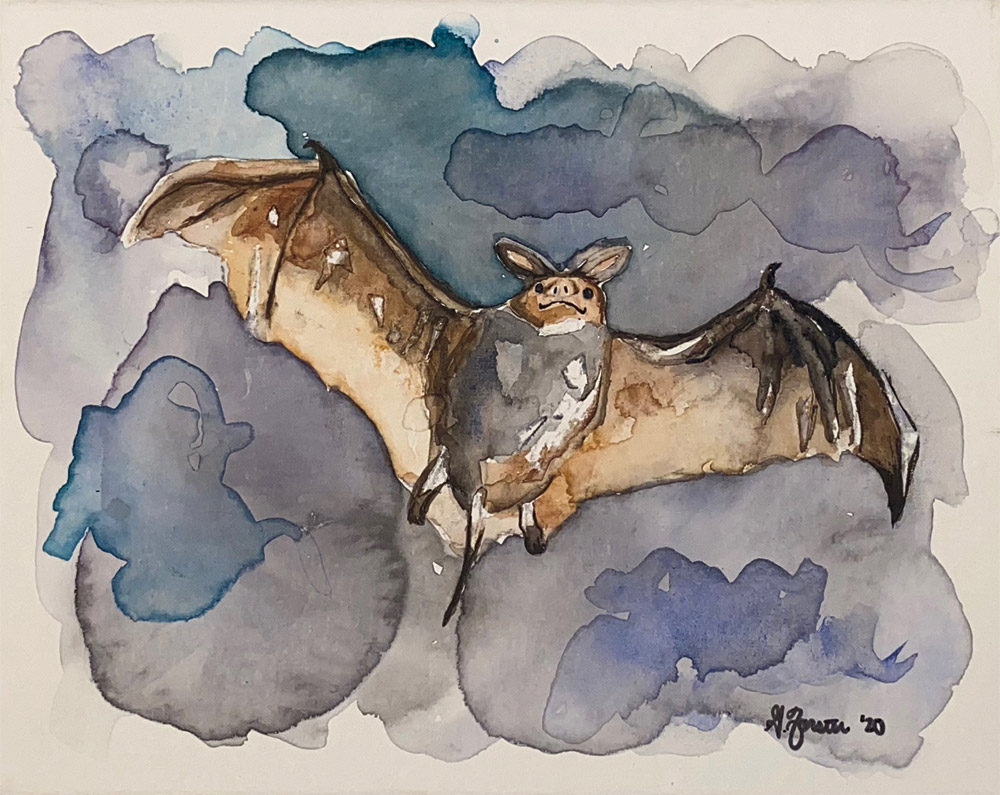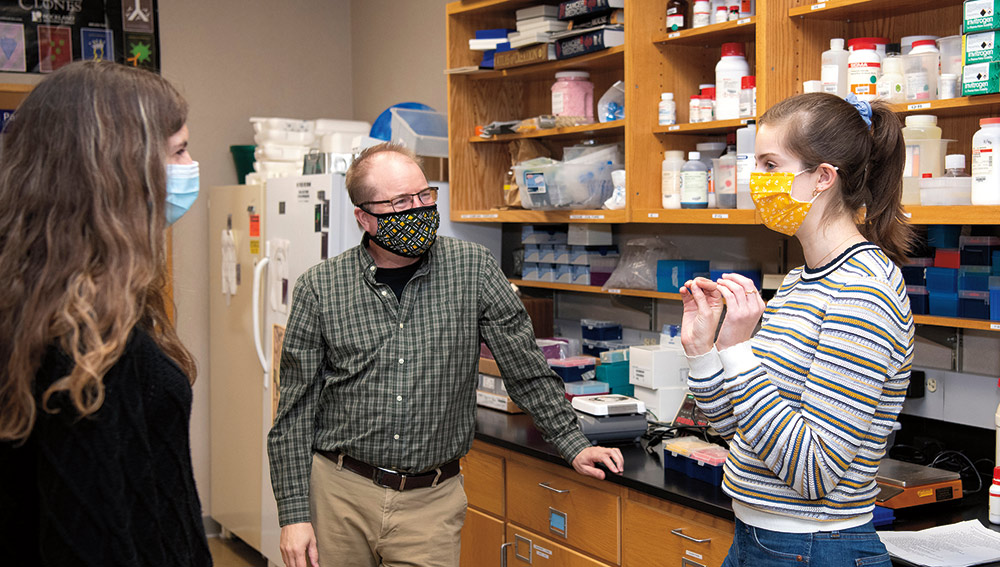


“Bats appear to manage viruses in a different way than other animals do,” says Professor DeeAnn Reeder, biology, who has been studying the flying mammals for more than 20 years. “They appear to be very good at tolerating them, and not dying from them.” She has teamed up with Professor Ken Field, biology chair, for a National Science Foundation- sponsored project to analyze how, on a molecular level, bats have developed that unique tolerance — and whether it might translate to humans.
That tolerance may have something to do with the way bats have evolved, says Field. Some species of bats eat up to their own body weight every night, including thousands of insects, to maintain their energy levels. “Many animals, when they get a viral infection, will huddle down — just like when we have the flu, we want to do nothing but curl up on the couch,” Field says. “But bats have to go out and hunt or forage — if they are not able to eat, they might be too weakened to fight off the infection.”
The mobility of bats is just one of the qualities that has fascinated Reeder during the decades she’s been studying the animals. “They are the only mammals that really fly, which makes them ecologically and physiologically unique,” she says. “They’re everywhere in the world and just have this incredible diversity. They are amazing.” After arriving in Bucknell in 2005, she established one of the largest research centers in the world for studying active and hibernating bats.

When the coronavirus first hit — with its suspected bat connection — Reeder considered how their team could contribute to research on the disease, and immediately thought of the thousands of samples of bat tissue kept in freezers in the basement of the biology building. While many samples were collected in North America, many also came from Africa.
“Some of the work we do requires euthanasia of the animals, and we don’t do that lightly,” Reeder says. To make the most of each procedure, she often freezes samples for future work. “We collect every tissue we possibly can.”
Graduate and undergraduate students frequently join Reeder in Africa to collect those samples, a process that involves stringing 18-meter mist nets in villages to capture fruit bats, which they gingerly extract from the tangle, wearing leather gloves. “It was definitely tedious and required a sharp focus so you didn’t hurt yourself or cause any extra trauma to the bats,” says Jordan Simpson M’21, a graduate student who accompanied Reeder to Uganda in 2018.

The biologists will use the tissue samples to investigate what enables bats to live with coronaviruses, including those related to SARS-CoV2. “Many people who die of COVID-19 are dying because of immunopathology — their immune systems are overreacting,” Reeder says. When a person becomes infected, she explains, their immune systems must perform a delicate balance, ramping up enough to fight off the infection, but putting on the brakes before causing harm to one’s own body.
“Those ‘brakes’ seem to be missing in the people who are getting very sick and dying,” Reeder says. “It’s probably not that they don’t have them, but sometimes the pathogens can be really sneaky and disable that braking system.” During a typical infection, cells produce chemicals known as cytokines to influence neighboring cells, including a class known as interferons, which heighten inflammation to bring more white blood cells to attack the virus.
The investigators plan to sequence the entire genome of every coronavirus they find in samples from as many as 200 different bats. They’ll also use a tool called transcriptomics, which can detect RNA created from the expression of different genes in the bat host cells. By examining which RNA is produced in response to which coronaviruses, they hope to determine which genes are being activated in response to the infection.
An outside company will do the actual sequencing of the RNA, which will return terabytes of data in the form of billions of letters that represent genetic code. Undergraduate researchers Isabel Steinberg ’23 and Morgan Thomas ’23 will use bioinformatic approaches to identify which genetic pathways are getting switched on and off in the different samples.

The first step toward solving that mystery will be to discover which coronaviruses have infected the bats sampled. The main varieties are alpha coronaviruses, which cause the common cold and are generally mild in humans, and beta coronaviruses, which cause much more serious infections, such as SARS, MERS and COVID-19. While African bats are often infected with both viruses, North American bats are only infected with the former. “We expect to find both alpha and beta coronaviruses in African bats, but only alpha coronaviruses in the North American bats,” Field says.
Field hypothesizes that comparing the bats’ immune responses to the alpha and beta coronaviruses may reveal a particular genetic response that helps protect the bats from a cytokine storm — the same sort that can wreak havoc on humans responding to the more serious viruses. That could take one of two forms, he says. “One is that the bats don’t turn on the inflammatory pathway that, when activated, causes all of the damage,” says Field. “They’ve co-evolved with these viruses for so long that they’ve lost the ability to respond to them in a way that is harmful.”
That, in turn, could help eventually develop drugs — or drug cocktails combining multiple drugs — that can recreate this bat-like response in humans. Says Reeder, “By identifying where these brakes are, we can basically say to the biomedical folks, ‘Look at what we found,’ and they can say, ‘Well, maybe this class of drugs would work best to dampen things.’ ”
At present, doctors treating COVID are forced to use powerful drugs such as corticosteroids to reduce the inflammatory response. Those are blunt instruments that block many different pathways at once, says Field. “So it might be preferable to have a more finely tuned target.” While such a therapeutic will likely take years to develop, the findings from the Bucknell study could help create treatments for future pandemics — as global warming and habitat destruction will inevitably lead to more disease transmission from bats to humans.
“We are in an era of pandemics, and there will probably be more viruses in this particular lineage,” Reeder says. “In reality, there’s going to be a COVID-25 or COVID-30. So anything we find will, I think, inform the field going forward on how to manage these things.”
Field and Reeder are hoping to receive funding soon for another study that would involve traveling back to Africa and challenging bats with virus particle vaccines to study the intricacies of their immune response. While all of the research they conduct is worthwhile, they say, they are especially grateful to have found themselves in the right place with the right tools to potentially contribute on an issue of such global significance.
“Basic science fills a gap and is always really valuable,” says Reeder, “but every now and then there is an opportunity for your data to be really important because of what is happening in the world. It’s amazing to be able to significantly contribute to the understanding of what is going on with these viruses.”